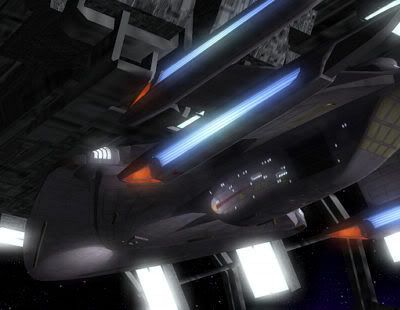1.1 MISSION OBJECTIVES
Pursuant to Starfleet Exploration Directives 1015.9 & 1020.16, Starfleet Defense Directives 200.0, 197.5 & 197.6, and Federation Security Council General Policy, the following objectives have been established for an Prometheus Class Starship:
1. Provide a multi-mission mobile platform for a wide range of scientific and explorative research projects.
2. Replace Excelsior, Ambassador, and Nebula class Starships as the primary instrument of Federation deep-space defense.
3. Provide autonomous capability for full execution of Federation defensive, cultural, scientific, and explorative policy in deep space or border territory.
4. Serve as a frontline support vehicle during times of war and emergencies.
5. Provide a mobile platform for testing and implementation of mission-specific or new technology of any kind.
1.2 DESIGN STATISTICS
Length: 415 meters
Width: 170 meters
Height: 113 meters
Weight: 950,000 Metric Tonnes
Cargo Capacity: 35,750 Metric Tonnes
Hull: Duranium-tritanium composite with micro-fiber reinforced ablative armor.
Number of Decks: 16 Total
1.3 GENERAL OVERVIEW
The Prometheus-class was one of if not the the most advanced Starfleet vessels in service as of the late 24th century. The Prometheus underwent many extended trials (both simulated and physical) and is the culmination of several separate research projects which were combined into one prototype test-bed vessel. Since it was so highly classified and possessed a hitherto unseen degree of automation only four Starfleet officers were trained on how to operate the Prometheus' systems before the vessel was deemed ready for active duty.
Among the Prometheus' state of the art features was the advanced type XII phaser arrays,quantum torpedoes, photon torpedoes, regenerative shield and Metaphasic shields augmented by a polaron modulator, and ablative armor with underlying Parametallic hull plating.
The Prometheus' warp engines were designed to be the fastest in the fleet with a cruising speed of warp 9 and a maximum speed of warp 9.99 (due to its tetryon warp plasma equipped warp nacelles). With these speeds being standard it was deemed necessary to develop a customized navigation system, the RAV/ISHAK Mod 3a warp celestial guidance system, specifically designed to handle the ship's high warp capability. The warp engines of the Prometheus Class were based on a scaled down version of the Sovereign class' warp nacelle design, which eliminated subspace distortion effects inherent to standard warp drives without the use of variable geometry nacelles.

A unique feature included in the Prometheus design was the multi-vector assault mode, which allows the ship to split into three semi-independent sections (or fully independent sections if there are sufficient crew members onboard) that could each deliver massive force against an enemy target. All three sections are warp-capable. Combined with the extensive automation, the Prometheus can be run by as few as four people. To allow this system to function it was again deemed necessary to develop a customized system for the ship, this one being the M16a tri-core bio-neural gel pack isolinear III processor.
In addition to standard automation systems, the design also featured omni-directional holo-diodes on every deck, which allowed the ship's Emergency Medical Hologram (Mark II as of 2374. Mark IV as of 2378) to access all areas of the ship (most EMHs were confined to sickbay only).
1.4 CONSTRUCTION HISTORY
The Prometheus Project was the research program initiated in 2359 as a project to design a starship whose sections each were equipped with a warp drive and reorganized into a combat ship program to develop the schematics for the Prometheus-class starship and construct the class prototype, the Prometheus. When the project was re-organized into a combat ship design program in 2364 it was decided by Starfleet Command to keep the Nebula-class USS Prometheus in service as a cover for the Prometheus class Project.

The 2359 version of the Prometheus class Project was created to explore the possibility of a true multi-section vessel able to separate into at least two independent sections, each with a fully functional warp drive of its own. One would be capable of launching an attack with almost the full ships weaponry, at high speed and manoeuvrability. The other, comprising the scientific, diplomatic and accommodation sections, would clear the area at high warp carrying the civilian complement. Much of the technology being developed for the Intrepid-class project was included in this design, with the result that the theoretical model finalized in 2363 bore a close resemblance to the Intrepid herself.
In 2364 Starfleet was considering moving to construction of the spaceframe of the multi-section starship. However, during this year, contact with the Romulans was re-established when the USS Enterprise (NCC-1701-D) encountered a warbird at the Neutral Zone. Since the warbird appeared to outgun the Enterprise - then Starfleet’s most powerful ship - by a considerable margin, Starfleet was confronted with what appeared to be a powerful and aggressive enemy. As part of their response, Starfleet requested a complete re-design of the multi-section starship. The new requirement called for an almost totally re-designed vessel; the ship would be in three sections, each of which would have an independent warp drive system. The scientific and diplomatic sections were mostly removed in favour of increased armament and power for the weapons. In place of the type-VIII phaser arrays that the original ship had shared with the Intrepid class, the type-XII phaser arrays from the Sovereign-class project were included. The shield system was upgraded with the auto-modulating shields of the Sovereign class. The advanced warp engine design included many elements of the Sovereign class, while the ablative armor, high capacity structural integrity fields and quantum torpedoes developed in conjunction with the Defiant class project were also included. The computer system was upgraded to a custom built system designated the M16a tri-core bio-neural gel pack isolinear III processor and the navigational system installed was a custom RAV/ISHAK Mod 3a warp celestial guidance system specifically designed to handle the ship's cruising speed of Warp 9 and maximum speed of Warp 9.99.
This technology combined to make the new starship one of the most massively armed and armored vessels of its size ever contemplated, let alone built. The small size combined with incredible speed and maneuverability when in multi-vector assault mode.
When the prototype USS Prometheus was launched in 2374 it was rated at having a combat capacity nine times that of the equally-sized Intrepid class, while her Type XII Phasers made her a formidable foe for any vessel in the alpha quadrant. These systems were so advanced and cutting edge that the Romulan Empire risked a war by attempting to intercept and commandeer the prototype vessel during its field trial phase. Their goal was to secure the Prometheus and navigate it into Romulan space to be retrieved by the Tal Shiar, for eventual analysis, and back-engineering of some of its advanced systems. Fortunately for the security and integrity of the Federation, the Romulans onboard were thwarted by the mark 1 EMH from the starship USS Voyager and the then-installed mark 2 EMH, before the Tal Shiar task force was engaged by a small band of Starfleet vessels spearheaded at first by the USS Bonchune then the USS Akira who forced the remaining warbirds to retreat.
The performance of the Prometheus during this accidental live-fire trial exceeded all expectations for the ship. With Starfleet losing ground against the Dominion, the class was moved into production. Although two of the class did participate in the Battle of Cardassia, the Prometheus class ships arrived in too limited numbers and too late to make a significant impact on the war as a whole.



















